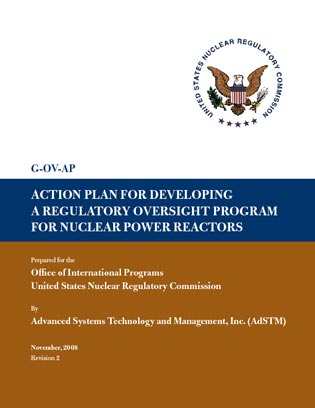G-OV-AP Action Plan for Developing a Regulatory Oversight Program for Nuclear Power Reactors

Table of Contents
- Introduction
- Overview of inspection activity
- Types of inspections
- Guidance for inspectors
- Summary
- References
Overview
In the decades since the accidents at Three Mile Island and Chernobyl, the international community has made significant progress in defining the elements needed for the development of national nuclear power programs. The International Atomic Energy Agency (IAEA) has produced numerous documents covering every aspect of nuclear power development, including the essential elements of a safety regulatory program. Individual countries have also made great progress in developing new approaches to regulation. These include risk-informed and performance-based approaches, which allow the regulatory agency to make optimal use of limited resources.
New reactor technologies, such as passive light water reactors and modular gas-cooled reactors, have been promoted in various countries, and some of these have gained the stamp of acceptance in the form of design certifications. Standardization of design and operations has been demonstrated in some countries.
The United States Nuclear Regulatory Commission (NRC) sponsors a program of international assistance to countries developing nuclear power programs. The program provides direct aid in three areas: development of regulatory agency infrastructure, creation of regulatory documents and training of regulatory staff. In the initial phase of this program the NRC has been working with three countries: The Republic of Kazakhstan, The Republic of Armenia and the Socialist Republic of Vietnam. In each of these countries, the development program has started with the preparation of an action plan. Those action plans have been tailored to the specific needs and capabilities of each country. The action plans are living documents, which will evolve as the program development progresses and more experience is gained.
The present document is a generic action plan template intended for use by other countries developing nuclear power oversight programs. It incorporates features from each of the three country-specific action plans developed to date. A new country approaching the challenge of developing a nuclear power oversight program can use this report as a starting point.
This action plan describes the overall philosophy governing regulatory framework. It outlines all elements of the program and describes the documents that are to be produced. The plan includes a list of the documents to be produced and presents milestones and schedules for their completion. The action plan is a living document; milestones and schedules will be revised as progress is made and as plans are clarified. This program can derive a significant benefit from activities of nations with well developed regulatory programs. For example, some countries have invested a significant effort in reviewing the safety of reactor designs. These reviews have resulted in design certifications. In some cases, complete designs have been licensed in the country of origin. If a certified or previously licensed design is proposed for licensing, the applicant may provide the safety evaluation findings of the country-of-origin regulatory agency to help demonstrate compliance with the requirements and guidance of the host country.
The multi-national design evaluation program (MDEP) is a formal effort to share design review information. MDEP may also make it possible for regulatory agencies to reference vendor inspections of facilities that fabricate large reactor components.
During licensing and operation of a nuclear plant, the regulatory agency will periodically request the assistance of the international community to conduct reviews and inspections in highly specialized disciplines. This can obviate the need to maintain technical capabilities across the full range of technical disciplines.
